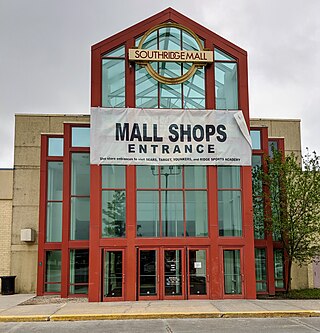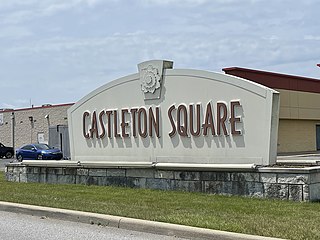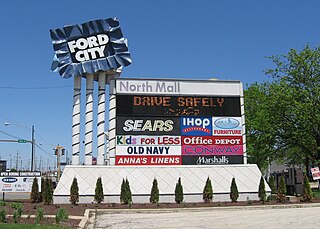
Del Amo Fashion Center is a three-level regional shopping mall in Torrance, California, United States. It is currently managed and co-owned by Simon Property Group.

Ross Park Mall is a shopping mall located in Ross Township, Pennsylvania, north of Pittsburgh. The mall houses 170 retailers including anchor stores Nordstrom, Macy's, and JCPenney. An outdoor lifestyle component complements the enclosed center.

Southridge Mall is an open-air shopping center on the south side of Des Moines, Iowa, United States. It attracts roughly 3.3 million visitors per year, with a primary trade area consisting of most of the city of Des Moines and areas to its south and east.

Uptown Janesville is an enclosed shopping mall located in Janesville, Wisconsin, United States. Opened in 1973, the mall has more than 68 tenants. The anchor stores are Dick's Sporting Goods, Ulta Beauty, and Kohl's. There are 3 vacant anchor stores that were once Sears, Boston Store, and JCPenney.
Christown Spectrum is the oldest operating mall in Phoenix, Arizona and was the third shopping mall built in the city. It is located at 1703 W. Bethany Home Road in Phoenix, Arizona. The name Christown Spectrum is derived from Chris-Town Mall and Phoenix Spectrum Mall, previous names. Today it exists as an enclosed shopping mall, although the enclosed portion of the mall was greatly reduced when redevelopment changed the configuration closer to a power center.
River Oaks Center is a shopping mall located at the southeast corner of River Oaks Drive and Torrence Avenue in Calumet City, Illinois, a suburb south of Chicago. River Oaks Center is the seventh largest in the Chicago metropolitan area totaling 1,379,824 square feet (128,190 m2). Today, there are over 140 stores and two anchors including JCPenney and Macy's with two vacant anchors last occupied by Carson Pirie Scott and Sears. Namdar Realty Group and Mason Asset Management manages and owns River Oaks Center.

Castleton Square is an enclosed shopping mall in the Castleton neighborhood on the northeastern side of Indianapolis, Indiana, United States. Built by Edward J. DeBartolo Corporation and Homart Development Company in 1972, it is owned and managed by Simon Property Group. It is the largest mall in the state of Indiana, and has remained so since its construction. The center's original anchor stores were JCPenney, Sears, Lazarus, and Woolworth. Expansions in 1990 and 1998 added to the total number of anchor and inline stores, while also adding a food court. The anchor stores are JCPenney, Forever 21, H&M, AMC Theatres, Dick's Sporting Goods, Macy's, and Von Maur; the former location of Sears has been vacant since 2018. Overall, Castleton Square consists of over 130 inline stores.
Westgate Center is a 640,000 sq ft (59,000 m2) regional shopping center located in the West San Jose neighborhood of San Jose, California. The mall is located at the intersection of Saratoga Avenue and Campbell Avenue. Current major anchor tenants include Burlington Coat Factory, Nordstrom Rack, Ross Dress for Less, TJ Maxx, and Target, along with Michael's, Old Navy, Gap Factory Store, and Nike Factory Store.

Springdale Mall is a shopping center located in Mobile, Alabama, United States, directly across from Bel Air Mall. Opened in 1959 as an open-air shopping center, Springdale Mall was later redeveloped as an enclosed shopping center. Facing competition from larger shopping centers in the area, Springdale was demolished in stages in the 2000s, with most of the former enclosed mall being replaced with big-box stores.

Ford City Mall is a shopping center located on the Southwest Side of Chicago in the West Lawn neighborhood at 76th Street and Cicero Avenue. Opened in 1965, Ford City is the largest enclosed mall in Chicago outside of downtown. Anchored by JCPenney, the mall contains more than 135 stores and restaurants including Applebee’s, Bath & Body Works, The Children’s Place, Foot Locker, Zales Jewelers, Marshalls, Old Navy, Victoria’s Secret/PINK, and Ross Dress for Less. There are several out parcels including a 14-theater AMC Theatres. Ford City Mall is managed by Mid-America Asset Managements.
Amigoland Mall was an enclosed shopping mall located in Brownsville, Texas. The former mall, which now houses a tech center, is now called the Brownsville ITEC Center.
Greenwood Park Mall is a shopping mall located in Greenwood, Indiana. The mall is the hub of the retail and commercial corridor along U.S. Highway 31 on the south side of the Indianapolis Metropolitan Area. As with several other central Indiana shopping centers, Greenwood Park Mall is owned and operated by Simon Property Group.
Park Plaza Mall is an enclosed shopping mall located in the Midtown neighborhood of Little Rock, Arkansas. Originally opened in 1960 as Park Plaza Shopping Center, an open-air shopping center, the mall is home to two Dillard's flagship stores and merchants including H&M, Talbots, and Eddie Bauer. The structure contains 545,800 square feet (50,710 m2) of retail space, although Dillard's owns 284,165 square feet (26,399.8 m2) of that area for its flagship stores.

Westfield Wheaton, formerly known as Wheaton Plaza, is a 1.7 million square-foot, two-level indoor shopping mall in Wheaton, Maryland, north of Washington, D.C. It is owned by Unibail-Rodamco-Westfield and Its anchor stores include Macy’s, Target, JCPenney, Dick's Sporting Goods, and Costco.
Lincoln Mall was a shopping mall located at the corner of U.S. Route 30 and Cicero Avenue in Matteson, Illinois, a south suburb of Chicago.

Randhurst Village, previously known as Randhurst Mall and Randhurst Center or simply Randhurst, is a shopping mall located at the corner of Rand Road and Elmhurst Road in Mount Prospect, Illinois. The mall took its name from combining the names of these two roads.
Florin Towne Centre, formerly Florin Mall and Florin Center, is an outdoor shopping center in the unincorporated area of Parkway-South Sacramento near Sacramento, California, United States. It opened in 2008 on the site of the old Florin Mall, which closed and was demolished in 2006. The 484,500 square feet (45,010 m2) center is anchored by AutoZone, PetSmart and Walmart Supercenter.

Forest Mall was an enclosed shopping mall in Fond du Lac, Wisconsin, USA. Opened in 1973, the mall closed and was demolished in 2020.
Bridgepointe Shopping Center is a shopping mall in San Mateo, California, United States. Opened in 1982 as San Mateo Fashion Island, it was originally an enclosed shopping mall featuring JCPenney, Bullock's, Liberty House, and Montgomery Ward as its anchor stores. Following the closures of Bullock's and Liberty House, the mall went into decline throughout the 1990s, leading to its closure and demolition in favor of a power center. Bridgepointe Shopping Center is owned and managed by CBRE Group. Major tenants of Bridgepointe Shopping Center include The Home Depot and Target.
NetPark Tampa Bay is a business park in the East Lake-Orient Park neighborhood of Tampa, Florida, United States. The complex, which primarily houses offices, is a redevelopment of the former East Lake Square Mall, a shopping mall built by Edward J. DeBartolo Corporation in 1976. The mall's anchor stores were JCPenney, Montgomery Ward, and Belk-Lindsey, with H. J. Wilson Co. joining in 1980. H. J. Wilson Co. became Service Merchandise in 1985, and Belk-Lindsey was sold to Dillard's in 1992. After a period of decline in the 1990s which included the closure of all four anchor stores, the mall was closed entirely in 1998 and officially reopened as NetPark Tampa Bay a year later.













